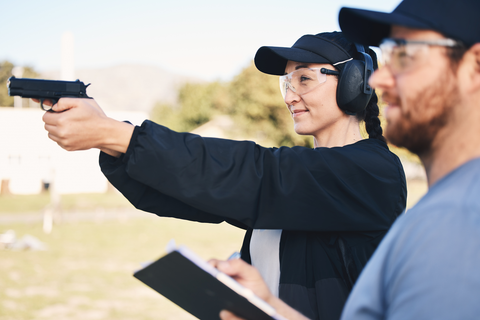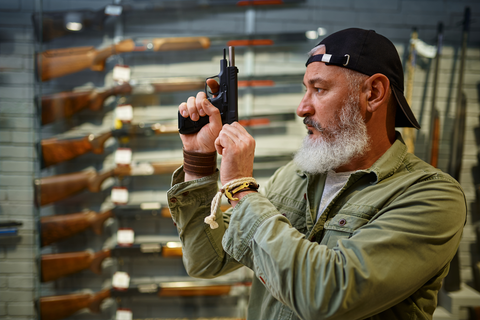The safety feature on your gun is essential for your protection and the safety of those around you. It's therefore important to know whether it's activated or not. A gun with the safety disengaged can be dangerous, especially when it's being holstered or if someone who shouldn't be handling it, like a child or a pet, gets ahold of it. To help you, we've put together this guide on how to check the safety on your gun. Let's get started.
What Is a Gun Safety?
Credit: Envato Elements/ Tonefotografia
A gun safety, simply put, is a mechanical device designed to prevent the firearm from firing accidentally. Think of it as a "lock" for your gun. This small feature plays a big role in keeping you and others safe.
So, how does it work? Well, it varies from one firearm to another. For some guns, the safety lever physically blocks the trigger from moving. In others, it might disconnect the trigger guard from the firing mechanism altogether. There are also safeties that prevent the hammer from striking the firing pin unless the safety is disengaged.
What Are the Different Types of Safeties?
When it comes to gun safeties, there are different types. Here's a rundown of the most common types you'll encounter:
1) Manual Safety
This is the classic safety feature most people think of. It's an external safety switch or lever that you manually engage or disengage. You can usually find it on the side of the gun and you use your thumb to flip it. For some guns, you push the lever up to turn the safety on, and for others, you push it down.
2) Trigger Safety
This type of safety is built into the trigger itself. It usually involves a small lever on the trigger that you need to press down completely to unlock it. This stops the main part trigger body from moving. This design has several moving parts, and it's useful because it means you have to press harder to pull the trigger.
3) Grip Safety
A grip safety is a lever found on the back of a handgun's grip. It needs to be pressed down by the shooter's hand, when holding the gun in a firing position, in order for the gun to shoot. It works like a manual safety.
4) Hammer Safety
A hammer safety is a latch built into the gun that stops the hammer from hitting the cartridge primer or firing pin when the gun isn't being used. This block is moved out of the way when the trigger is pulled all the way.
5) Decocker
Not exactly a safety in the traditional sense, but it's worth mentioning. A decocker is a lever that safely lowers the hammer from a cocked position without firing the gun. Here's how it works: When you push or slide the lever, it gently lowers the hammer from its cock (ready-to-fire) or half cock position back to its uncock (safe) position. This happens in a controlled manner, making sure the hammer doesn't touch the firing pin, so that there's no accidental discharge.
Can You Rely on Your Gun's Safety?

Credit: Envato Elements/ YuriArcursPeopleImages
No. While a gun's safety mechanism is designed to provide a level of security, it's not foolproof. Mechanical devices can fail, and relying solely on the safety could lead to dangerous situations. A safety is more of a backup and not the primary means of ensuring your firearm is secure.
For utmost safety:
- Treat the gun as if it's loaded and ready to fire, even when the safety is on.
- Always follow proper gun handling practices.
- Never point the gun at anything you don't want to shoot. Only point at the intended target.
- Properly secure your gun when you're not using it.
- Don't let someone inexperienced with firearms handle your gun.
How to Tell If Your Gun Safety Is On or Off?
Here's how you can easily check the status of your gun's safety:
- Look for visual indicators: Many firearms come with visual cues to help you quickly identify whether the safety is on or off. A red dot or marking often means the safety is off (ready to fire), while the absence of the red indicator typically means the safety is on.
- Feel for physical indicators: Sometimes, the position of the safety lever or button itself is a clear indicator. Safeties that are engaged (on) often sit flat or close to the body of the gun, while disengaged (off) positions may stick out or move to a distinctly different position.
- Check the manual: If you're unsure, the best source of information is the firearm's manual. Each gun can be a little different, so familiarizing yourself with your specific model's safety features is crucial.
- Verify with an Expert: If you're still uncertain about the status of a firearm's safety mechanism, ask for help from someone with expertise in firearm safety. This could be a certified firearms instructor, a knowledgeable friend, or a staff member at a reputable gun store or shooting range.
Maintenance Tips for Your Gun's Safety

Credit: Envato Elements/ NomadSoul1
Keeping your gun's safety mechanism well-maintained is just as important as taking care of the rest of your firearm. Here are some simple tips to ensure your safety feature remains reliable:
- Regular cleaning is key: Just like any other part of your gun, the safety needs to be kept clean. Dust, dirt, or residue can build up and potentially interfere with its function. Use a small brush and appropriate cleaning solvent to gently clean around the safety mechanism. When doing this, make sure that you're not handling a loaded firearm.
- Lubricate sparingly: After cleaning, apply a small amount of lubricant to the safety mechanism to ensure smooth operation. Be careful not to over-lubricate, as too much oil can attract dirt and grime, which could lead to malfunctions.
- Check for wear and tear: Regularly inspect the safety for signs of wear, damage, or any irregularities in its operation. If you notice anything unusual, it's best to have it checked by a professional gunsmith to prevent any safety failures.
- Practice proper use: Misusing the safety mechanism can lead to unnecessary wear. Always engage and disengage the safety gently, without forcing it. Forcing the mechanism can damage it over time.
FAQ Section
Should I engage the safety mechanism while cleaning my gun?
Before cleaning your gun, make sure it is unloaded. The safety should be engaged as an additional precaution, but the primary safety measure is ensuring that you are handling an unloaded gun.
Can all guns be fitted with a safety mechanism?
Most modern firearms come with built-in safety mechanisms, but not all. Some older or specific models might lack this feature. Always check the manufacturer's specifications for your firearm.
Is it safe to rely on a gun's safety when handing it to another person?
No, the safest practice when handing a gun to another person is to ensure the firearm is unloaded and the action is open, regardless of the safety position. Always treat the firearm as if it could fire.
What should I do if my gun's safety mechanism is not working properly?
If you suspect any issues with your gun's safety, stop using the firearm immediately and consult a professional gunsmith for inspection and repair. Do not attempt to fix the safety mechanism yourself.
Summary
In conclusion, determining whether a gun safety is on or off requires a combination of visual inspection, understanding of the firearm's design, and following firearms safety rules at all times. By following these guidelines, you can minimize the risk of accidents and ensure responsible gun ownership.
And don't forget to improve your shooting skills with EasyShot! Our shooting targets are designed for accuracy and fun. Shop with us today.


